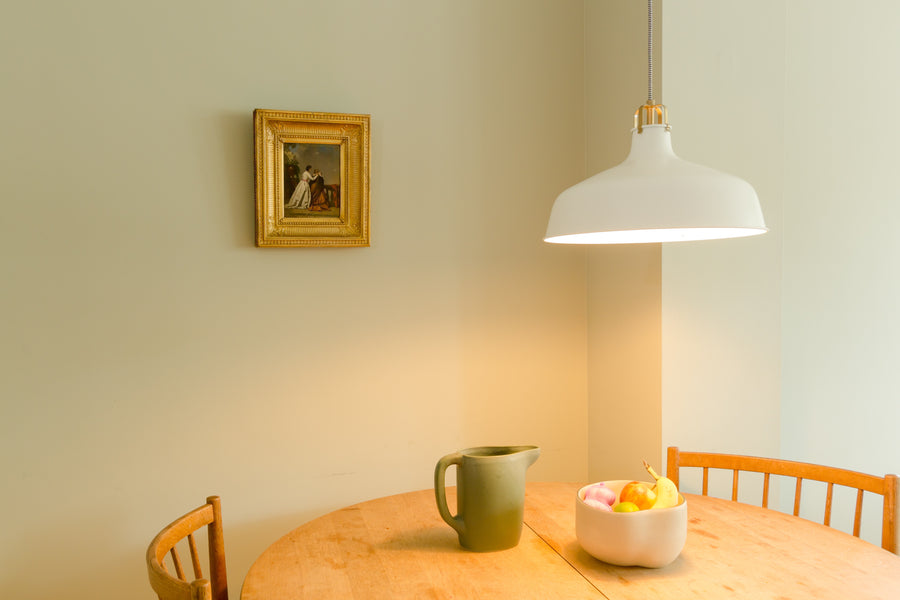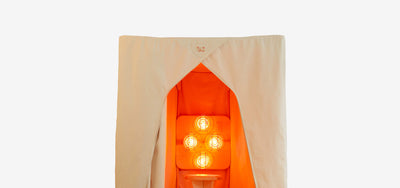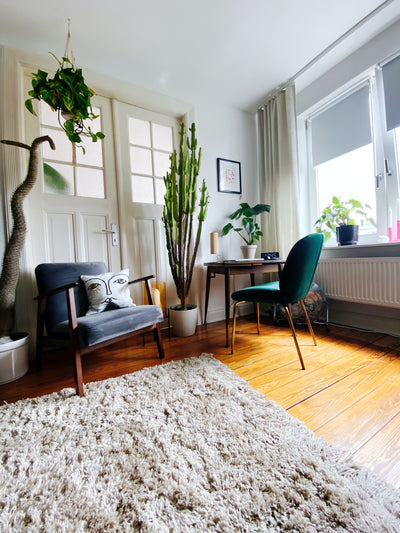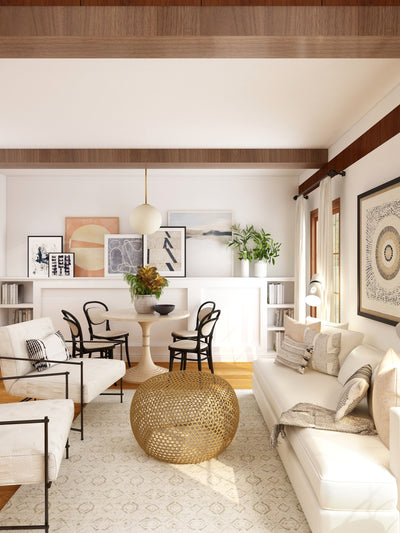The hidden dangers of LEDs – and the healthiest type of home lighting

The humble lightbulb. It’s something you probably haven’t paid much attention to, beyond the inevitable groan when one goes, leaving you in darkness and requiring a replacement. And yet how we light our homes and indoor spaces can have unexpected and wide-reaching effects on our health and wellbeing.
The light-emitting diode (LED) has largely replaced incandescent and halogen lamps and bulbs thanks to its energy-saving credentials. But blue light-heavy LED lighting comes with hidden risks – from disrupted circadian rhythm and sleep to macular degeneration and mitochondrial dysfunction.
Read on to discover everything you need to know about LEDs, their potential pitfalls – and the healthiest alternative options to illuminate your home and optimise your wellbeing…
What are LEDs?
A light-emitting diode (LED) is an electronic light source that emits light when current flows through it.
Until the 1990s, LEDs were only available in red, yellow or green and were used as indicator lights in basic electronic equipment like alarm clocks or remote controls.
With the creation of the first blue LED in 1992, by combining it with a material that re-emits photons in longer wavelengths, it became possible to create a white light intense enough for use in lighting.
What are the main sources of LED light today?
With energy-saving higher up the agenda than ever, and the phasing-out of incandescent and halogen lamps, we’ve seen a boom in energy-efficient LEDs in recent decades.
LEDs are now used in devices and settings as diverse as lightbulbs, car headlights, traffic lights, advertising boards, glowsticks, camera flashes, ships’ navigation lights, stadium displays, railway stations and airports. This means our exposure to blue light has increased sharply in a relatively short space of time.
What is blue light, and what has it got to do with LEDs?
According to the charity Prevent Blindness:
“Sunlight is made up of red, orange, yellow, green, blue, indigo and violet light. When combined, it becomes the white light we see. Each of these has a different energy and wavelength. Rays on the red end have longer wavelengths and less energy. On the other end, blue rays have shorter wavelengths and more energy. Light that looks white can have a large blue component, which can expose the eye to a higher amount of wavelength from the blue end of the spectrum.”
So, while sunlight may be the main source of blue light, this natural form always comes balanced with the other colours in the spectrum, which offset its effects. Beneficial near infrared, for example, is ever-present in sunlight, making up to 43% of its total radiation energy.
“The blue light under the sun is never a solitary event,” explains Dr Alexander Wunsch, a physician, researcher and lecturer in light medicine and photobiology.
“If you are using high-intensity blue light from an LED,” Dr Wunsch continues, “the problem is that there is no [beneficial] compensation radiation contained within.” The same goes for all other sources of artificial blue light – from smartphones to tablets, computers to TV screens and e-readers.

How does blue light affect human health?
“Blue light is the main signal for our vision and non-vision system to find out if it is day or night,” says Dr Wunsch. “The problem is, we are able to produce artificial light with significant amounts of blue, which signals to our system that it's in the middle of the day.”
Disrupted sleep
Several studies demonstrate that even low exposure to blue-rich light in the evening can affect our finely-tuned circadian clock, delaying or inhibiting nocturnal melatonin production and throwing sleep patterns and quality off-kilter. Read more about the impact of blue light on sleep here.

Eyesight damage
Acute exposure to intense blue light may also lead to eye damage and even partial or total loss of vision over time. A 2018 study found that “short-wave blue light is closely related to eye light damage,” explaining how “this high-energy blue light passes through the cornea and lens to the retina causing diseases such as dry eye, cataract, and age-related macular degeneration.” Some LED lighting devices, including hand-held lamps, head torches and some smartphone and tablet screens emit particularly blue-rich light. Read more about the impact of blue light on eyesight here.

From depression to diabetes
Studies have even shown that blue light-induced body clock disruption may be linked to a whole range of mental and physical health conditions, such as “depression, diabetes, hypertension, obesity and cancer”.
Do LEDs equal a big increase in blue light?
According to Dr Wunsch, “LEDs produce more blue light, because the primary light source in white light LEDs is a blue LED.”
The unique characteristics of LEDs enable them to emit more short-wavelength light, known as “blue-rich” light. This blue-rich light is more intense than other light sources, leading to undesirable effects on human health and the environment.

A damning national report on the dangers of LEDs
In 2019, the French National Agency for Food, Environmental and Occupational Health & Safety (ANSES), published a 424-page report on the health effects and potential hazards of LEDs.
The culmination of several years of research – including analysis of over 600 scientific publications, the report stresses the “disruptive effect on biological rhythms” of blue-rich LED lighting, stating that “LED lighting and objects significantly increase exposure to blue light.”
The report cites “the toxicity of blue light to the eye, which can lead to failing eyesight” and an increased “risk of developing age-related macular degeneration,” as well as the ability of “even very low levels of exposure to blue light in the evening or at night” to “adversely affect sleep duration and quality.”
ANSES’ expert appraisal showed that “a high proportion of LED lamps have significant variations in light intensity,” which may make some groups of people, such as children, adolescents and workers more susceptible to “headaches, visual fatigue and risk of accidents”. The report also found that the LED screens of “computers, smartphones and tablets are major sources of blue-rich light.”
Following its findings, ANSES made a series of recommendations to limit the French population’s exposure to blue light, and suggested adapting the regulatory framework for all LED systems. These recommendations included:
- Restricting the sale of LED objects to the general public
- Limiting the intensity of vehicle lights
- Minimising the flicker of the light emitted by all light sources

The problem with light ‘flicker’ and LEDs
Natural light sources do not pulse. Artificial light sources, on the other hand, can generate imperceptible flicker.
LED lamps, for example, are super sensitive to fluctuations in electrical currents, causing a phenomenon known as “temporal light modulation” – AKA flicker.
In the Human Optimised Lighting Guide, EMF mitigation specialist Brian Hoyer writes that, “artificial light sources from bulbs plugged into the electrical grid are running on 50 or 60Hz AC pulsed electrical frequencies. When a light source runs directly from these electrical frequencies, it will pulse at the same rate as that source of power. This means that the light will be flickering on and off on AC electricity at 120 times per second.”
Though imperceptible, this flicker causes the eyes to constantly adjust – “but the brain doesn’t process the information fast enough to produce an image of flickering that your eyes are exposed to,” writes Brian.
Imperceptible light flicker from LEDs can lead to headaches, visual fatigue, migraines, and, ultimately, to “hormone disruption, because of stress on the hypothalamus/pituitary glands,” explains Brian. “These glands depend on the eyes for signals from the light environment to regulate circadian biology, and the nervous system 'rest and digest' or fight or flight stress response.”

Healthier options for lighting your home
BioLight™ - Full Spectrum Light

BioLight™ is the first full spectrum light bulb of its kind, with three separate modes to suit the time of day and support your circadian rhythm.
Replicating the same balanced visual colour spectrum as natural sunlight, the Full Spectrum Day Mode boosts daytime energy, uplifts mood and increases overall wellbeing. Mixed Mode provides a warm, low-blue light with the same visible spectrum as incandescent lights, whilst Night Mode offers a 100% blue light-free amber light – similar to a warm and relaxing candle glow – to promote peaceful sleep.
SaunaSpace Photon Red-Filtered Incandescent Light Therapy Lamp

Near infrared is always present in natural sunlight, compensating for the stress caused by the shorter wavelengths in the spectrum.
Known as photobiomodulation, red light therapy involves exposing the body to beneficial red or near infrared light to increase mitochondrial function, reduce inflammation, stimulate healing and improve blood flow and tissue oxygenation. Read more about the benefits of red light here.
Not only does the SaunaSpace Photon red-filtered light therapy lamp deliver portable, therapeutic-standard near infrared mitochondrial stimulation at home, gently warming you for a natural, anti-inflammatory energy boost – it also helps reduce flicker stress from computer or TV screens and LED lighting. Plus, it’s EMF-free.
Twilight Red Light Bulb

As the most optimal bulb to use before bedtime and during the night, the Twilight Red Light Bulb features a relaxing, low-EMF red-light spectrum that is guaranteed to be 100% blue AND green light-free and produce zero flicker. Use it in reading lamps, bedside lamps or bathroom lighting to set yourself up for a dreamy night’s sleep.
Sweet Dreams Sleep Light

Featuring a warm, amber-spectrum light, the Sweet Dreams Sleep Light is an ultra-healthy light bulb designed for use throughout the home. 100% blue light-free, low EMF and with zero flicker, you can use this bulb in any main light throughout the home (replacing most 40w and 60w bulbs) for maximum melatonin production, producing deep and restful sleep whilst still providing sufficient brightness and colour.
From night lights to torches and reading lamps, discover the full BlockBlueLight healthy lighting range here.

Featured Collections
Featured Products
Tara Says
"Lighting is a vastly overlooked issue, but if addressed well can have continued health and sleep benefits for the whole family."
Tara Williams, Conscious Spaces Founder & CEO

































